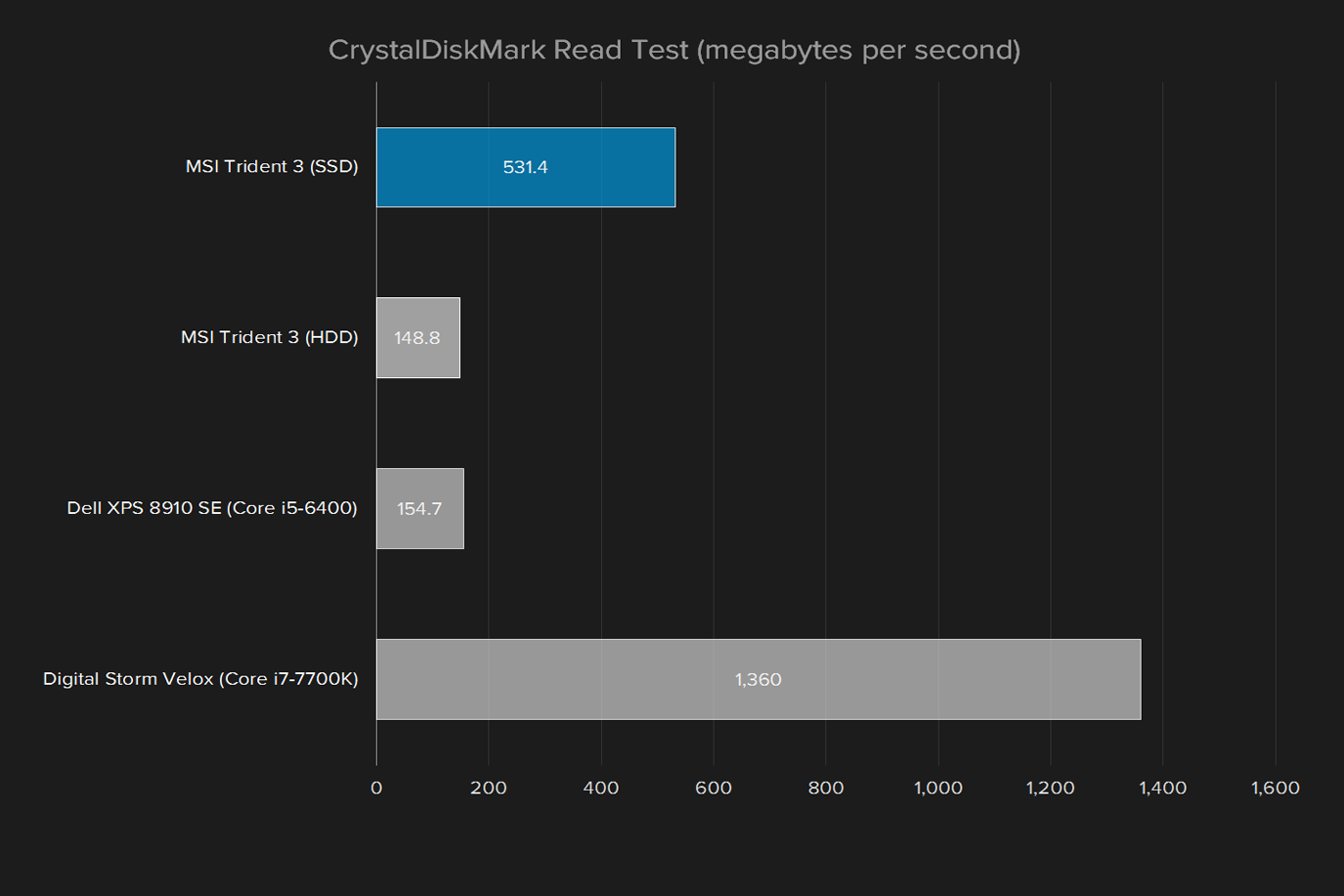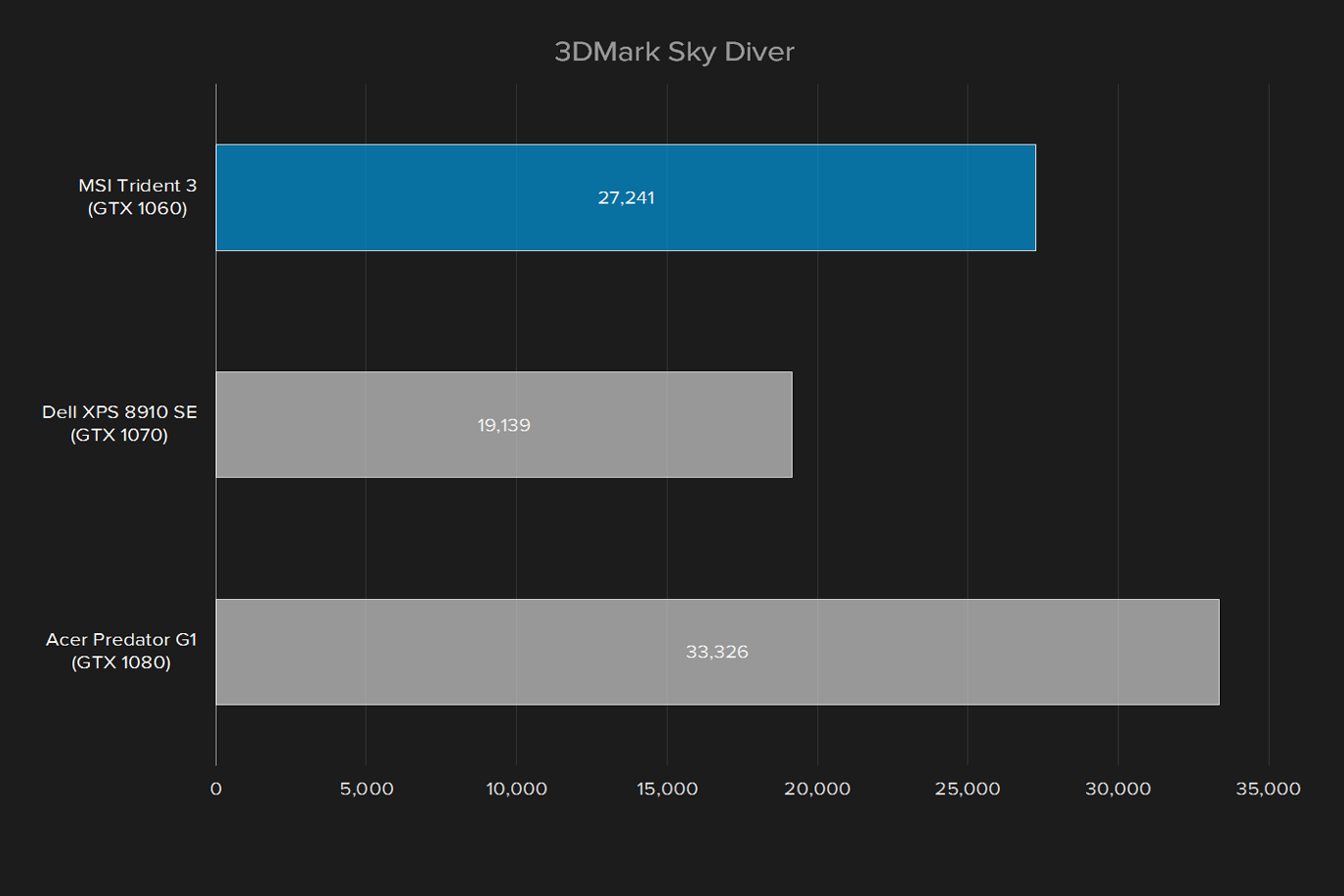- Compact design
- Sturdy feel
- Solid 1080p gaming
- Tons of plugs
- Bloated with extra software
- Odd port selection
Gaming PC manufacturers have been chasing the dream of a console-sized gaming PC for years, and as Intel, Nvidia, and AMD have improved power and thermal efficiency over the last few years, there’s been some success. Yet the combination of power and affordability required in a small gaming rig remains a difficult recipe, and one MSI has struggled with in the past.
Now, MSI is trying its hand at that category once again, this time aided by the appropriately mid-range GTX 1060 with 3GB of RAM, and an Intel Core i7-7700HQ with 16GB of RAM, all for right $1,300. It doesn’t quite cut the price as low as more mundane desktop offerings from competitors, but its compact size could be worth the extra cash. Is the Trident 3 a perfect fit for your living room? Or has the recipe soured once more?
Always improving
With the Trident 3, MSI has strayed a bit from the red-and-black look that’s become synonymous with gaming computers, ditching it in favor of RGBLEDs on the system’s corners. This simple switch is a welcome change, lending the system a more versatile look. It should have no trouble sneaking into a home theater cabinet, or alongside other consoles, thanks to its compact design.
MSI’s quality has matured in recent years, and the Trident 3 follows that trend with sturdy panels and an attractive, striking look. That said, the stiff panels aren’t put together tightly, so there are still spots where light leaks through from the internal LEDs. Sitting next to a TV, though it’s unlikely anyone will notice a few panel gaps.
Many plugs, but the wrong kind
The Trident 3 doesn’t skimp on connectivity. The front panel houses three USB 3.1 ports — two Type-A and one Type-C — 3.5mm audio in and out, and an HDMI port for virtual reality, which we’ll discuss in more detail in a moment. Around back there’s gigabit Ethernet, another Type-A USB 3.1 port, four USB 2.0 ports, HDMI for the internal GPU, and the VR link HDMI port.
Out of the box, both the internal GPU HDMI port, and the VR Link HDMI port, are plugged with plastic stoppers. The VR Link requires an included HDMI jumper from the GPU into the port on the back. The system then passes that signal to the port on the front for a VR headset.
The Trident 3 has no trouble sneaking into a home theater cabinet alongside other consoles.
It’s a nice thought with some practical problems, the most obvious being the GPU, which only sports one HDMI, one DisplayPort, and one DVI. That means there’s no easy way to simultaneously plug in a VR headset and a HDTV (a DisplayPort to HDMI adapter could do the trick). Also, the HDMI pass-through only brings the port up about 10 inches, and an Oculus Rift will have to plug into the USB 3.1 port on the back anyway, with the Oculus trackers plugged into the front. That rather minimizes the advantage of the HDMI port on the front.
Like many small form factor systems with ITX motherboards, the Trident 3 sports 802.11ac Wi-Fi and Bluetooth 4.2. If we’re just counting ports, the Trident 3 punches up a weight class, but its graphical outputs keep it limited to home theater or living room applications. It seems like an avoidable problem, considering the system sports an MSI GPU.
Familiar parts
The process for opening the system wasn’t immediately obvious. As it turned out, we had to pry back a panel on the bottom of the case to reveal the four screws holding the side panel on. Once inside, we were greeted by familiar, off-the-shelf parts. The motherboard isn’t anything special or clever, it’s just a standard ITX motherboard. The cases’ GPU area is small, but it’s nothing most half-length cards can’t squeeze into, as long as they don’t need extra PSU power.
You’re stuck with the blower cooler on the CPU, as it’s unlikely you’ll find anything efficient enough that will fit, but everything else is off the shelf. RAM is easily accessible, and there’s space for a 2.5-inch SSD or HDD around back, next to an M.2 slot. There’s basically nothing inside you couldn’t replace or upgrade if you wanted to, except the power supply, which is an external unit.
The processor holds up
Our configuration sported an Intel Core i7-7700, a four-core CPU with Hyper-Threading, and 16GB of RAM. Apart from a lack of overclocking support and a lower 65-watt TDP, the chip bears a close resemblance to the enthusiast Core i7-7700K, and should provide excellent performance for the size.
As a side note, our MSI Trident 3 was an engineering sample with a bit of an odd configuration. It packed in the higher-end CPU and GPU, with 16GB of memory, but only a 128GB SSD. The more typical $1,300 model sold at retail includes a 256GB model. This won’t impact processor performance, but it’s worth noting.
No surprises here. The Intel Core i7-7700 holds its own against similarly-minded systems, taking a strong lead against the slightly more budget-friendly Dell XPS 8910 SE. The Core i7 makes an even bigger difference in the Handbrake 4K video conversion test, where it dominates the Core i5-6400 in the XPS 8910 SE.
Whether it’s synthetic or real-world benchmarks, the MSI Trident 3’s performance is commendable, and for the price point, very competitive. The Digital Storm Velox beats it out by a wide margin, but its Intel Core i7-7700K chip is much more expensive, in a higher-end system, with a lofty 5GHz overclock on it. For what it is, the Core i7-7700 in the Trident 3 holds its own quite well.
Storage and options
MSI outfitted our review unit with a Kingston 128GB SATA SSD and a 1TB mechanical HDD. The SSD holds the OS and any demanding applications or oft-used files, while the larger mechanical drive keeps extra files and media. It’s a cost effective option, and one that provides a lot of versatility.
As expected, the SSD’s read speeds far outweigh its mediocre write speeds, a trend we see in most drives like it. It shouldn’t drag while loading big applications, and makes startup lightning fast, although our review unit only boasted 128GB, which we quickly filled with games. Higher-end systems like the Digital Storm Velox are moving to PCIe and NVMe drives, but for the price point, we don’t expect that.
Instead, MSI has thrown an extra HDD inside, a 1TB data drive in our case. It’s unsurprisingly slow and lumbering, but it will allow you to stash extra games or movies without having to use up a plug with an external option. Its competitors aren’t always as thoughtful, and the Dell XPS uses only a mechanical drive, which is far from ideal.
Not a runner
MSI portrays the Trident as a gaming system, so we’ll make sure to put it through the full ringer of graphical benchmarks. Equipped with a 3GB GTX 1060 from MSI, it should be capable of pumping out decent framerates at 1080p, unless its petite size gets in the way.
Nothing scary to report here. The Trident 3 holds its own under the demanding 3DMark graphical test, with the CPU allowing the GTX 1060 to basically run at its full potential. Both the XPS 8910 SE and Velox take a strong lead here thanks to their improved graphical options. The 3DMark benchmarks tend to be a lot harder on the CPU than most modern games, so it’s always worthwhile to see how it fares against commonly played PC titles.
Steady jog
Most games don’t challenge the CPU very much, and our test suite is indicative of that. Sid Meier’s Civilization VI tends to be the only game that puts a lot of stress on the processor, while the rest place most of the strain on the GPU. Still, we want to see how the combination fares together, and whether the CPU holds up the potential performance.
While it might look like a trouncing for the little Trident, it’s once again betrayed by the more premium systems it competes with. It’s more than capable of holding a 60 FPS average in most modern titles, an increasingly big ask for gaming computers.
Although we didn’t include it on our graphs, due to lack of direct competitors we have results for, the Trident 3 averaged 82 FPS at ultra in Battlefield 1, and 76 FPS in For Honor. Both are modern titles without heavy CPU demands, and both are ready to run quite well on that 1080p television hooked up in front of the couch.
It may not reach the upper echelons of gaming power, but with so many users still playing at 1,920 x 1,080, and so many televisions sitting at 60Hz, the Trident 3 targets the perfect performance spot.
Cut the crap
We’ve tested MSI systems in the past, and we’ve often noticed a problem with lots of pre-installed software. The Trident 3 was no exception.
Annoying bloatware holds it back.
The usual suspects made an appearance, with a handful of MSI control panel and optimization apps, and something called Houzz, which has to do with home design. We have no idea why that’d be included on a gaming rig.
Any bloatware is too much, but Norton Security is a particularly virulent strain. It constantly bothered us with notifications about files and applications. Norton also repeatedly tried to install several Chrome extensions that Google classifies as potentially threatening.
Warranty
MSI covers the Trident 3 and its internal components for one year. That’s not exactly luxurious for a gaming PC, but it’s similar to what you’ll find on other mid-tier systems from major manufacturers, including the Dell 8910 SE.
Unlike previous Trident models, MSI says it’s perfectly fine to open up the Trident 3 and replace or upgrade parts. That said, MSI’s warranty won’t cover any damage due to user maintenance, so make sure to work carefully.
Our Take
MSI has packed a decent all-around gaming system into a compact box that won’t look out of place between a cable box and a Playstation 4, and there’s something to be said for that. Still, the small form factor market is growing quickly, and the Trident 3 is far from the most refined, or budget-friendly system on the list, at $1,300 for the closest configuration to our review unit.
Is there a better Alternative?
Alienware’s Alpha R2 does the same thing in a much smaller footprint, and the best model is available for $949, but it still sports a GTX 1060 and mobile processor. The Zotac Magnus E Box undercuts the Trident price-wise, although the best models are barebones, so users will have to bring their own SSD and RAM.
How long will it last?
MSI’s little box certainly has the hardware to last through a few graphical update cycles over the next few years. It’s a system meant to sit next to a television, and if that television is 1080p, it’s happy to oblige.
Should you buy it?
No. While the Trident 3 offers decent performance in a compact size, there are too many solid alternatives that don’t have its problems with bloatware, and offer a better value. The Alienware Alpha is a simple, no-nonsense option with slower parts at a better price, and Zotac’s offerings offer more variety and plenty of upgrade options.


















